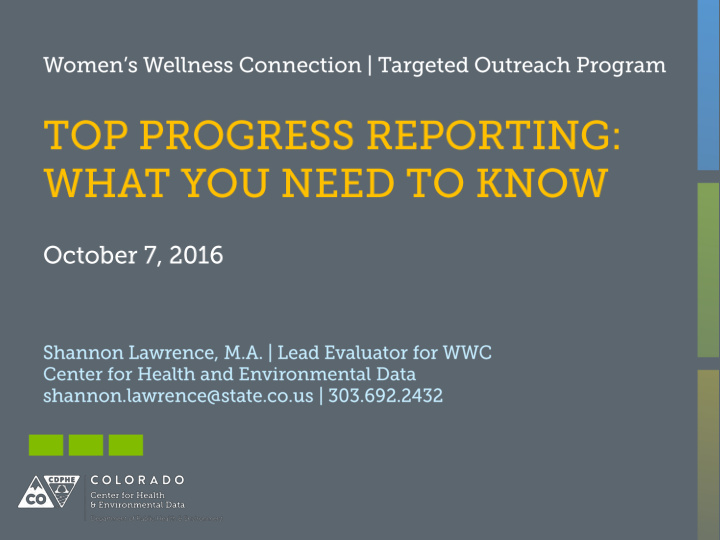



• Introduction & welcome • Outcomes & expectations • Purpose & use of progress reports • Timing & process of progress reports • Demonstration • Resources • Questions & answers
Ivy Hontz, WWC Program Coordinator Kris McCracken, WWC Program Coordinator Shannon Lawrence, WWC Lead Evaluator
Clinica Tepeyac • • Denver Health and Hospital Authority • Heart of the Rockies Regional Medical Center (HRRMC) Foundation • Inner City Montrose Memorial Hospital • • Penrose Saint Francis Hospital • Somali American Community Center of Colorado (SACCC) • San Juan Basin Southern Colorado Family Medicine • St. Mary Corvin Medical Center • Southern Ute Spanish Peaks Outreach and Women's Clinic • • St. Thomas More Hospital Uncompahgre Medical Center • • Ute Mountain Ute • Weld County Department of Public Health
At the end of this webinar, participants will be able to understand what progress reports are; why they are important; how to complete them; and where and when to submit. Ask questions at any time. We’re here to help.
The WWC Targeted Outreach Program provides financial support for local initiatives that utilize evidence-based interventions, education, referrals and Community Health Worker outreach efforts to improve access to local breast and cervical cancer screening providers for underserved women. Purpose: Expand outreach efforts to underserved women, including women eligible for WWC Clinical Services, particularly those populations with higher rates of breast and cervical cancer. Goal: Increase the number of women screened for breast and cervical cancer in Colorado.
• Program monitoring – Ensure program is being implemented as planned and that contract goals are on track for completion – Identify technical assistance needs & priorities so that we can help you achieve success • Program evaluation – Improve understanding or modify thinking about program (effectiveness, outcomes, cost, etc.) – Make specific changes to program overall – Make decisions about program expansion
Quarter Reporting period Due date Quarter 1 Jun 30 – Sep 30 Oct 17 (Survey Monkey) Nov 3 (Excel) Quarter 2 Oct 01 – Dec 31 Jan 15 Quarter 3 Jan 01 – Mar 30 Apr 15 Quarter 4 Apr 01 – Jun 29 Jul 15 • New link to survey will be mailed each quarter. Complete survey online. • Update and email same excel file each quarter to evaluator unless you are provided a revised version.
1. Narrative (Survey Monkey) 1. Description of quarterly activity. 2. Successes and what led to them. 3. Failures, needs and plans for change. 4. Does not include numbers. 2. Data (Excel file) 1. How many activities/women served 2. Numerical description of activities/women
• Occurred DURING the reporting period for that quarter. • Are DIRECTLY funded through TOP .
• TOP Data Reporting Guide Draft emailed to agencies on Sept 13 Final version available at TOP Summit on Oct 25 • CDPHE Evaluator: Shannon Lawrence Get questions in before 10/19! Not available week of 10/24. • CDPHE Program staff: Ivy Hontz Kris McCracken
Q: Can we add a line if the languages that we translated materials into are not listed…to differentiate between those languages that might be lumped together? A: The Excel file is locked, which may prevent you from adding rows or adjusting auto-calculations. Options: If you translate materials into one other language, enter that • number into “Other” and report the specific language on the narrative (survey). • If you translate materials into more than one other language, contact Shannon.Lawrence@state.co.us before October 18 to update your data worksheet.
Q: What about other swag, like water bottles, would that be included as a client incentive? A: Swag, while a marketing incentive, is not considered an evidence-based intervention. In your narrative please talk about the type of swag being distributed. Keep in mind, handing out swag must be connected to women being educated and screened.
Q: For client reminders, many/most of those women are also getting one-on-one and scheduling. Do you want us to count those separately? We are tracking both. A: Yes, please count each of these activities separately, even if they apply to the same woman. Think of it this way: if 1,000 women are recruited, how many of them receive: 1:1 education? appointment scheduling assistance? client reminders?
Q: What about reporting activities where the cost is eaten by our organization but it applies to our TOP work? A: As part of our evaluation, we may ask about your organization’s overall costs to implement TOP in an effort to better understand the costs of providing outreach, but you are not required to track or collect this information
Q: How do we know if woman receiving screening services were referred through TOP? A: Each TOP-funded organization should track women from the point of first contact to referral and screening, including follow-up to confirm whether or not screening was completed. When referring a woman to an agency funded by WWC to provide screening (WWC Clinical Services) or navigation of insured women to screening (Care Coordination Grant Program) — including your own organization — please notify the agency during the warm hand-off that they should select “Targeted Outreach Program (TOP)” from the pull -down menu for “how client heard of the program” when entering information into eCaST (their data reporting system). We will work with new grantees separately to determine the best solutions for your organizations.
Recommend
More recommend